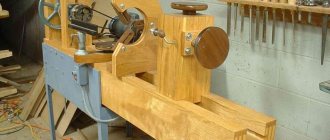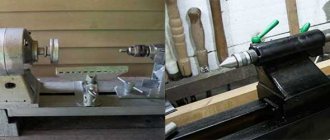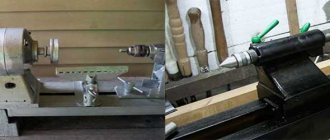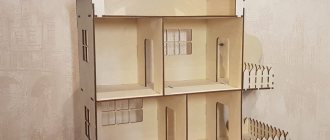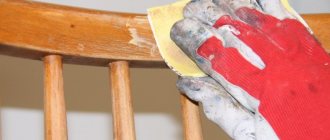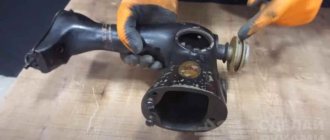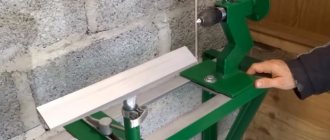Home » Reviews » Review of wood lathes
Wood lathes are used in furniture production, in the manufacture of baguette frames, other interior elements, and in the creation of crafts. This equipment allows you to produce parts of cylindrical, conical, and round shapes.
Also often found is a wood turning and milling machine, a type of lathe with an additional milling function (for creating grooves).
When choosing a wood lathe, take into account the scope of application. The devices are produced in a wide range and differ in power, parameters of processed wood models (minimum and maximum), speed adjustment function (or lack thereof), and distance between centers. It is also worth paying attention to the features of the spindle, the presence or absence of a digital display, and reverse. The listed technical parameters and descriptions of the machines can be viewed in the corresponding section of the Stanew catalog.
Features of wood lathes
In a number of cases, a hardworking owner has a desire to make furnishings and utensils that have a circular cross-section throughout their entire length.
Most often these things are:
- Holders for hammers and files;
- Stair posts, flowerpots, handles for railings;
- Rolling pins, potato presses, grape crushers;
- Vertical pencil cases;
- Cups, mugs, saucers, plates, trays, stoppers.
It will be impossible to cut such things with planes and saws. In this case, you will need at least the most primitive machine.
Buying a lathe
Today you can purchase such a device with a click of the mouse by going to a specialized online store. True, such a purchase will hurt your pocket, especially if you choose a high-quality model and not a cheap Chinese craft.
However, this does not mean that the idea of founding a miniature workshop will have to be given up. The problem of high cost can be solved by taking a different route. A simple and durable electrical unit must be made by hand.
Turning round architectural decorations
Such a mechanism will be an excellent help if you need to make inexpensive repairs to a cottage equipped with
- Flights of stairs with wooden balustrades;
- Decorative trims;
- Carved shutters;
- Window earrings.
Profitable and promising business
Having gained some experience in the production of decor, it will be possible to move from banal savings to a profitable business. This could be the production and sale of chess pieces. If you sell them through online auctions or retail chains, then an additional source of income will appear in the family budget.
Handmade items quickly find demand, especially if they are offered for sale at a reasonable price.
In the future, this hobby will develop into full-time commercial employment, giving you a chance to acquire professional tools and start earning very good money.
Main components
The most important components of such a device include
- Bed;
- Electric drive;
- Front and back headstock;
- Stand for accessories.
Support frame base
The bed is a frame that allows you to connect all the parts into a harmonious mechanism. The strength and reliability of such a support directly determines the stability and durability of the entire device. It is better and easier to use a steel angle to make the frame; another suitable material is a rectangular profile.
First of all, it is necessary to mark the dimensions of the assembled automatic sharpening machine. These parameters are determined by what exactly this machine will be used for. As a rule, a stand for an apartment or garage modification does not exceed eighty centimeters in length.
Frame manufacturing process
The slats selected for assembling the frame must be laid so that their upper edges are strictly in the same plane. The parallelism of these guides is checked by measuring the distances between their ends on each side.
- Longitudinal fragments are secured with clamps. The transverse parts are made from the same profile.
- There will be three crossbars in total. Two of them are fixed at the edges of the device, and the third is placed a couple of tens of centimeters from the left end.
At the next stage, all components are joined by welding into a solid composition. It is important that the resulting connecting joint is strong and smooth.
Do-it-yourself machine assembly
If buying a wood lathe for your home seems too simple, then you can try to make such a device yourself. To do this, you will need to use a drill drive with a power of no more than 150 W. For the frame, you can use a wooden base or light alloys. The main requirement for the design is that the headstocks must be at the same level and their centers coincide.
Depending on the selected body material, guides are selected. There are many options, from slats machined from wood to self-mounted aluminum rails.
Selecting an Electric Powertrain
When choosing a motor to power the turning system, it is necessary to clarify how powerful it is. For the construction of a homemade self-heating unit, an indicator in the range of 1.2 - 2 kW is quite sufficient. In this case, you should find out exactly what scheme the connection is made according to.
For desktop woodworking, a motor from a household centrifuge is sufficient. Although he is not able to provide turning of a massive workpiece, he will definitely master the processing
- Miniature souvenirs;
- Kitchenware;
- Various types of furniture accessories.
Review of the most popular models
wood lathe Jet-1442
Let's look at the characteristics of several models of lathes for amateur use.
| Kinzo 48P5600 | Proxxon DB250 | Jet JML-1014i | Caliber STD-350 | Corvette 71 | |
| Type | desktop | desktop | desktop | desktop | desktop |
| Power, W | 350 | 100 | 370 | 350 | 370 |
| Electric motor type | asynchronous | collector | collector | collector | asynchronous |
| Rotation speed, rpm | 850 — 2150 | 1000-5000 | 500 — 3900 | 500 — 3400 | 760 — 3200 |
| Maximum workpiece dimensions | 1000 x 350 | 250 x 80 | 350 x 250 | 330 x 250 | 420 x 250 |
| Spindle size | 1 x 8″ | M16x1 | 1 x 8″ | 1 x 8″ | 1 x 8″ |
| Weight, kg | 38 | 2 | 30 | 17,5 | 38 |
Table 1. Technical characteristics of lathes for home
Kinzo 48P5600: the bed is made of rectangular pipes, it is possible to use an extension for processing workpieces longer than 40 cm. You can change the speed of rotation of the workpiece by rearranging the belt on the pulleys (4 pairs). When purchasing such a machine, you should pay attention to the alignment of the front and rear axles. When pressed by the rear stand, the base may become deformed. Fragile plastic handles with clamping bolts.
Jet JML-1014i: solid cast iron frame. The rotation speed changes smoothly in several ranges. To change the range, you need to move the belt on the pulley. It works very quietly, it is convenient to set the speed on the electronic unit. To lock the spindle, a push handle is provided, which is located on the left.
Proxxon DB250: aluminum frame, very small in size, allows you to turn only the smallest parts for aircraft modeling. During operation, it is advisable to attach the device to a workbench, otherwise the light alloy structure will dangle. It works very quietly, there is no beating, but the power of the machine is low, so you need to work carefully and slowly.
Corvette 71: cast iron frame, rotation speed is changed by rearranging the belt pulleys. Despite its small size, the design is no different from professional turning equipment. The engine maintains stable speeds, practically does not vibrate and makes no noise. The tool rest is short, it is clearly not enough for internal turning of parts longer than 110 mm. Equipped with a convenient eccentric mechanism for rearranging the tool rest.
Caliber STD-350: neat frame made of cast iron. The center of the rear and front axles may not coincide, which is very difficult when working with short parts made of dense wood. The spindle does not hit, it is easy to adjust, the frame is durable, and it works quietly. Weak frequency regulator - torque at the minimum position is almost impossible to use.
Functional front lock
For figured turning, the workpiece is fixed between two clamps, which are usually called headstocks. At the same time, torque from the electric motor is transmitted to the front, and therefore it will be somewhat more difficult to assemble it.
The front clamp of a home lathe is an iron U-shaped structure, between the sides of which a shaft and a pulley system are mounted on bearings. The body is assembled from thick rolled steel segments.
Methods for securing the workpiece
Two methods can be used to secure a part on turning equipment.
- Between the centers of the headstock and tailstock.
- Using a faceplate.
The first method of fastening is the most common. Most often it is used for processing short bars without the need for end processing. With this method of fastening, the accuracy of fastening is of great importance. It is important that when the workpiece rotates, there is no situation of part runout. To eliminate this, use an angular center finder.
The second method is more reliable, which is used in cases where processing of the ends of the workpiece is necessary. It differs from the first fastening method in that it is fixed using bolts or chuck teeth. This fastening ensures reliable retention of the part when performing comprehensive turning of the workpiece.
A lathe designed for processing wooden blanks differs from a metal lathe by the presence of a manual feed of the cutter, which is a chisel or other cutting tool for wood. It is secured only if a copier is used . In all other cases, when processing a workpiece, the chisel is held by the master. He also controls it manually, relying on the thrust bearing when performing the operation. The only thing that is done automatically is the spindle rotation speed.
The whole process takes place in two stages. First, roughing is performed, which is performed at an angle of 15-30 degrees. Upon completion, finishing is carried out at an angle of 45 degrees. When performing both operations, the chip thickness should be no more than 1 mm.
Installation of the second clamp
The purpose of the rear analogue is to support the conditional cylinder to be sharpened and provide it with freedom for rapid rotation. The more firmly the tailstock holds the workpiece, the better the final result will be.
- An indispensable condition for proper installation of the second clamp is maintaining alignment with the first.
- Faced with great difficulties at this stage, it makes sense to significantly simplify the task by purchasing a completely finished unit.
The use of an electric drill chuck will allow you to significantly modify the engineering solution. A shaft is clamped in it, the end of which must be pointed.
How to choose the right one
To ensure that the choice of a wood lathe is correct, experts advise focusing on the following criteria:
- power;
- dimensions and weight;
- size of processed elements;
- spindle rotation speed;
- thickness of processed parts;
- availability of additional functions.
If you plan to use a lathe for processing small parts, as a hobby, then the priority will be not accuracy and power, but noiselessness. In this case, it is recommended to pay attention to low-power models that emit minimal noise or to models equipped with noise protection. To work at home, it is enough to purchase a lathe with a power of no more than 500 W.
To process workpieces of different sizes in home workshops, you can use machines with a power of 500 - 1000 W. Large machines reduce vibration during operation, so if space in the workshop allows, it is better to choose larger models.
When choosing a wood cutting machine, you should take into account the dimensions of the parts being processed. For a summer residence, it is enough to purchase a household model of the device. If you have to process a lot of material every day, it is recommended to buy a high-quality professional wood cutting machine.
It is also important to choose the correct distance between the centers of the tailstock and headstock or faceplate. These values may vary between models. They influence the accuracy of fasteners.
Often, when working with wood, it is necessary to change the speed of rotation of the workpiece. Therefore, when choosing a wood lathe, pay attention to whether it is equipped with a speed controller. You can adjust it stepwise or smoothly. With smooth adjustment, it does not need to be disconnected from the network; all processes occur smoothly and without sudden jerks.
For processing soft wood, experts recommend choosing machines with a spindle speed of 400 rpm. Hardwood will require a high speed unit. The maximum spindle speed is 3500 rpm.
When purchasing a wood lathe, you should pay attention to whether it has additional advantages, for example:
- Digital display. Makes it easier to work with workpieces, as you can visually control all processes, especially in problem areas.
- Auxiliary copier. Allows you to make many identical parts.
- Reversing eliminates the need to re-feed the workpiece, thereby speeding up the work process.
When choosing a wood lathe, it is important to study it first, and before purchasing, you should carefully compare all the pros and cons of different models and manufacturers.
How to choose a wood lathe - video
Design and principle of operation
A wood lathe is made up of parts that complement and enhance each other. In addition to the main components, it can be equipped with various devices designed to work with wooden parts.
A wood lathe consists of the following main components:
- Bed. To ensure the stability of the machine, all its parts are secured using a heavy frame. These are two vertical ribs attached to a fixed base. You can store tools and accessories in the lower compartments. Transverse rails are attached at the top to move the caliper and tailstock.
- The headstock consists of a chuck, a bearing and a machine control system. Inside there are movable gears, with the help of which the spindle rotates, various threads are cut, etc.
- The tailstock is a moving unit. Thanks to the tailstock, there is additional fixation of the workpiece by pressing it with the tailstock, in other words, it serves to support the workpiece during processing in the centers. It will also help to cut threads or drill a hole in the workpiece; for this, drills or taps are inserted into the quill.
- Stop for the cutter (handle). This is a movable element that can move both parallel and perpendicular to the axis of the machine and be fixed in the right place.
Thanks to the listed main components, the lathe copes with the assigned tasks of wood processing.
The operating principle of wood lathes is based on the method of processing the workpiece with a cutting tool (cutter); only the feeding of the cutting tool can differ: automatically or manually.
Before starting work, the workpiece is mounted in a chuck or on a faceplate, depending on the size and shape of the workpiece. After this, the tool rest is installed in the required position for comfortable work with the cutter.
It is important to check whether the tool rest is touching the workpiece; to do this, simply turn the workpiece secured in the chuck by hand and see whether it catches the tool rest or not.
Basic methods of securing a workpiece
Parts can be fixed on a lathe in two ways:
- between the centers of the headstock and tailstock;
- using a chuck or faceplate.
The first fastening method is considered the most common and reliable. It is used to process bars of large length or diameter without end processing. When rotating the workpiece, you must also ensure that there is no runout.
The second method of securing the workpiece is used in cases where it is necessary to process the ends of the workpiece or those that cannot be clamped into the chuck. The workpiece is secured with bolts, clamps or teeth. The fastening allows you to securely hold parts when performing comprehensive turning of workpieces.
The work is done in two steps. On the first one, rough processing is done at an angle of 15 - 30 degrees. Then they begin finishing at an angle of 45 degrees.
Convenient turntable
All that remains is to make a tool rest, where needle files, jigsaws, sandpaper, planes and hacksaws will be laid out during work. Its outlines are not regulated in any way, but it must be completely comfortable.
It is better to design such a table with the participation of the master who will become the main user of the automatic sharpener.
The best option is a swivel stand in the shape of a trapezoid. It is cut out of a thick iron sheet, after which it is mounted on a rotary hinge with a large two-way angle. It will be easy to move such a table in order to bring files closer to you or move them away for a while.
Types of machines
All equipment intended for wood processing can be divided into three groups:
- Industrial wood lathes that weigh a lot but have powerful motors. Designed for large volumes of work, therefore they can provide greater productivity.
- Small industrial. Their distinctive feature is a power not exceeding 500 W. Designed for use in small workshops. They weigh about 70 kilograms.
- A tabletop wood lathe, its use is advisable in cases where it is necessary to process one or more parts. It is installed on a table, is compact, lightweight and does not produce much noise during operation, which makes it possible to use it at home.
Tabletop wood lathe
Of course, all machines can be divided into other categories based on functionality. This includes combined and specialized devices. The former are much more expensive and cannot always provide improved quality of material processing, so it is more advisable to use specialized types for one purpose or another:
- If you need to bore a groove or machine it, then turning and milling machines are the best choice.
- Lathe screws are suitable for creating cone-shaped workpieces or for applying threads.
- CNC machines allow you to write a program in advance, which the device will follow without the direct participation of the master.
It is worth saying that regardless of which model you choose, they will all be able to perform a common set of functions:
- pruning;
- drilling;
- applying threads and grooves;
- making openings and drilling holes;
- turning.
The only difference is that machines designed, for example, for cutting threads, will do such work perfectly, while another model may cope with the task worse.
DIY wood lathe
Cutters of different calibers
Cutting attachments are sold in every major hardware supermarket. At the same time, it is possible to buy both single cutting parts and sets.
With a wide selection of cutters available, the turner will create any complex and intricate configurations, including
- Grooves;
- Chamfers;
- Cones;
- Dashed lines;
- Edging;
- Wavy lines.
Application area
Lathes are used for internal and external machining of cylindrical surfaces. Shafts, bushings, flanges, pulleys, couplings and other parts can be manufactured.
The workpiece is installed in a chuck, which rotates together with the spindle at specified speeds. The cutting tool makes a translational movement. Due to this, the workpiece acquires the desired shape and size.
Types of operations:
- End processing.
- Grinding the outer surface to a given diameter.
- Drilling and boring holes.
- Grooving.
- Cutting internal and external threads.
- Reaming and countersinking.
